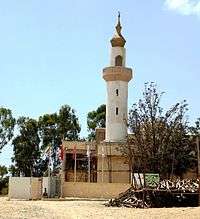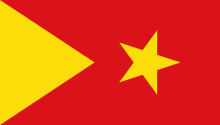Negash
| Negash | ||
|---|---|---|
 | ||
| ||
 Negash Location in Ethiopia | ||
| Coordinates: 13°52′53″N 39°35′56″E / 13.88139°N 39.59889°ECoordinates: 13°52′53″N 39°35′56″E / 13.88139°N 39.59889°E | ||
| Country | Ethiopia | |
| Region | Tigray | |
| Zone | Misraqawi (Eastern) | |
| Population (2007) | ||
| • Total | 7,753 | |
| Time zone | UTC+3 (EAT) | |
Negash is a village in the Tigray Region (or kilil) of Ethiopia, which straddles the Adigrat-Mekele road (Ethiopian Highway 2) 10 kilometres (6.2 miles) north of Wukro. Located in Wukro woreda.
History
Negash is considered to be the earliest Muslim settlement in Africa; a cemetery from the 7th century CE has been excavated inside the village boundaries.[1] The Futuh al-Habasha records Ahmad ibn Ibrahim al-Ghazi visited the tomb of Ashama ibn Abjar in Negash during his invasion of the province of Tigray (around 1537).[2] Negash is also known for having one of Africa's oldest mosques,[3] that is the Negash Amedin Mesgid.
Demographics
In the statistical tables of the 2007 census published by the Central Statistical Agency, the kebele Negash is located in is reported to have a total population of 7,753 of whom 3,607 are men and 4,146 women; they are distributed amongst 1,689 households in 1,626 housing units. Although it is known for its particular relationship with Islam, 98.2% of the population follows the Ethiopian Orthodox Tewahedo Church, the 1.1% of the population is Protestant, and the remaining 0.7% is Muslim.[4]
See also
References
- ↑ Paul B. Henze, Layers of Time: A History of Ethiopia (New York: Palgrave, 2000), p. 43.
- ↑ Sihab ad-Din Ahmad bin 'Abd al-Qader, Futuh al-Habasa: The conquest of Ethiopia, translated by Paul Lester Stenhouse with annotations by Richard Pankhurst (Hollywood: Tsehai, 2003), pp. 350f
- ↑ "Liste des premières mosquées au monde prophètique, rashidun et omeyyade selon les écris historique et les traces archéologiques". Histoire Islamique (in French). 2014-06-15. Retrieved 2017-09-24.
- ↑ "Tigray Statistical Table", Annex Table 1B CSA website (accessed 27 August 2010)
